How The Ritz-Carlton's Famous Blueberry Muffins Improved Over Time
The Ritz-Carlton is probably best known for being the epitome of luxury hotels, but its Boston location is known for something more fit for you foodies: serving famously delicious blueberry muffins. The berry-filled breakfast pastry has been served at the hotel since it opened in 1927. Back then, we're sure the muffins were delicious, but in 1971 executive pastry chef Charles Bonino went on a mission to develop an even better recipe.
Boston's iconic (and now closed) department store Gilchrist's was known for its version of blueberry muffins, so Bonino turned to the store for inspiration. The story goes that the pastry chef purchased loads of these muffins and analyzed them in an attempt to reproduce them. No matter the point of inspiration, it must have worked because the recipe has been shared for generations — but apparently, it's come out that Bonino was never completely satisfied with his results.
How the recipe was rectified throughout the years
Once Bonino retired, his successor Gunther Moesinger sought out to improve the recipe more. After his own baking tests, he eventually swapped out shortening for butter, added more blueberries and eggs, among a couple of other changes. This recipe eventually made it to The New York Times by food columnist Marian Burros in 1985, where it's been published — and republished — by pastry chefs and food bloggers for decades.
Shortening is typically cheaper than butter and has a longer shelf life — so perhaps Bonino used shortening during his career at the hotel to maintain a better budget. But in case you're wondering why Moesinger made these specific changes, there are several potential reasons. The switch to butter can help create a delicate crumb and richness to muffins and baked goods in general. Adding more blueberries gives you more tangy sweetness in every bite, while extra eggs can give your breakfast treats more moisture and structure.

